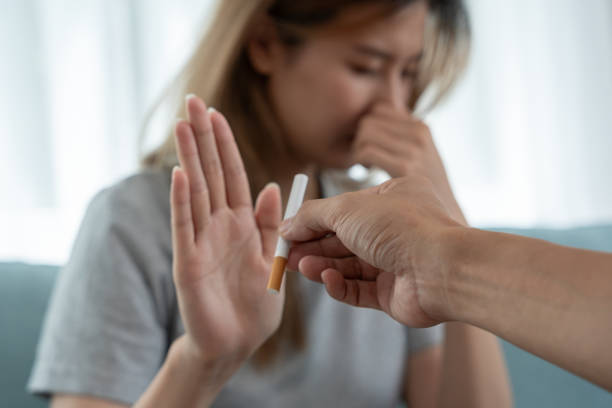Health
How Smoking Damages Your Skin and Weakens Your Bones
Thinking of smoking that cigarette? You might want to reconsider starting smoking, especially if you’re worried about the health of your skin and bones. Smoking has a negative impact not just on your lungs, but also on your skin and bones.
In fact, smoking can cause premature skin aging, making you look older than you are. Toxins in cigarettes narrow blood vessels in your skin, limiting oxygen and nutrition flow and causing dullness, wrinkles, and collagen breakdown. Not only does smoking damage your skin, but it also weakens your bones. According to research, smokers are more likely to develop osteoporosis and fractures.
Cigarettes’ toxic chemicals interfere with bone remodeling, resulting in lower bone density and an increased risk of fractures. So, if you want to keep your youthful glow and healthy bones, it’s time to lay down the cigarette for good. Your skin and bones will thank you.
How Smoking Affects the Skin
Smoking has a negative impact on the health and look of the skin. The chemicals in cigarettes have a significant influence on the blood vessels in your skin, causing them to constrict. This narrowing inhibits blood flow, lowering the quantity of oxygen and nutrients available to skin cells. As a result, the skin loses important nutrients, resulting in a dull complexion and slower wound or blemish recovery. Furthermore, smoking harms collagen and elastin, the proteins responsible for the skin’s suppleness and firmness. Wrinkles and fine lines appear as collagen breakdown occurs over time.
Furthermore, smoking reduces the skin’s ability to fight damaging environmental influences. The poisons in cigarettes produce free radicals, which are unstable chemicals that damage healthy cells and create oxidative stress. This oxidative stress harms the DNA of skin cells, hastening the aging process and increasing the risk of skin cancer. Furthermore, smoking reduces the formation of Vitamin A, an essential ingredient for good skin. Without enough Vitamin A, the skin’s natural defensive mechanisms weaken, making it more vulnerable to UV radiation and contaminants.
Quitting smoking is the most effective strategy to reverse skin damage. Once you quit, the blood vessels gradually return to normal function, allowing for better blood flow and food supply to the skin. This improved blood circulation helps to rejuvenate the complexion, giving it a healthier and more youthful appearance. Quitting also slows collagen degradation, allowing the skin to regain suppleness and lessen the appearance of wrinkles. Quitting smoking can help you regain a vibrant and refreshed complexion.

Common Skin Conditions Caused by Smoking
Smoking is a major contributor to many skin disorders. Acne is one of the most frequent smoking-related diseases. Cigarette carcinogens impair the body’s delicate hormonal balance, resulting in an increase in sebum production. Excess sebum, coupled with dead skin cells and germs, clogs the pores and causes acne. Smokers frequently have more severe and chronic acne breakouts than nonsmokers.
Furthermore, smoking worsens preexisting skin disorders including psoriasis and eczema. The toxic chemicals in cigarettes cause inflammation in the body, exacerbating the symptoms of several disorders. Psoriasis smokers are more likely to have large and resistant plaques, whereas eczema smokers may have more frequent and severe flare-ups.
Another skin ailment linked to smoking is oral leukoplakia. This disorder appears as white or grey spots on the inside of the mouth, including the tongue, cheeks, and gums. mouth leukoplakia is caused by persistent irritation from smoking and can progress to mouth cancer if left untreated. Quitting smoking is critical for limiting the spread of oral leukoplakia and lowering the risk of oral cancer.
Smoking and Premature Aging of the Skin
Smoking speeds up the aging process of the skin, resulting in premature wrinkles and other symptoms of aging. Cigarette carcinogens contribute to the degradation of collagen and elastin, the proteins responsible for the skin’s structure and elasticity. Additionally, smoking lowers blood flow to the skin, depriving it of vital minerals and oxygen. This diminished blood supply impairs the skin’s capacity to mend itself and inhibits the formation of new collagen.
The affects of smoking on the skin grow more visible as you age. Smokers frequently acquire deep creases around their mouths, commonly known as “smoker’s lines.” These lines are caused by repeated muscle movements while smoking, as well as skin elasticity loss. Smoking also causes the production of crow’s feet, which are thin wrinkles that occur at the corners of the eyes.
Furthermore, smoking causes the skin to lose its natural glow, appearing dull and sallow. The chemicals in cigarettes interrupt the regular cycle of skin cells, causing an accumulation of dead skin cells on the surface. This buildup inhibits light from reflecting off the skin, making it dull and less bright.
Quitting smoking is critical for regaining the vibrancy and youthfulness of your skin. As the body continues to mend after stopping, blood flow to the skin improves, supplying nutrients and oxygen. This increased blood circulation helps to renew the skin by decreasing the appearance of wrinkles and restoring its natural glow. Quitting smoking also restores the skin’s capacity to create collagen, resulting in firmer, more supple skin.

The Impact of Smoking on Bone Health
In addition to its negative effects on the skin, smoking is a major risk to bones as well. Research has consistently demonstrated that smokers are more likely to develop osteoporosis, a disorder characterized by reduced bone density and an increased risk of fracture. Smoking interferes with the bone remodeling process, which is responsible for the skeletal system’s strength and integrity.
Cigarettes’ toxic chemicals disturb the equilibrium of bone synthesis and resorption, encouraging bone loss over new bone growth. Smoking reduces the activity of osteoblasts, the cells that create new bone formation. At the same time, it increases the activity of osteoclasts, which are responsible for breaking down old bone tissue. This imbalance causes a net loss of bone mass and a decrease in bone density.
Smokers are also more prone to have delayed bone healing following fractures or surgeries. Toxins in cigarettes reduce blood flow to the bones, limiting the delivery of oxygen and nutrients required for normal repair. As a result, smokers may have longer recovery durations and a higher risk of problems including non-union or malunion of fractures.
Smoking and Increased Risk of Osteoporosis
Osteoporosis is a disorder in which bones are weaker and fragile, leaving them more prone to fracture. Smoking raises the chance of developing osteoporosis, especially in postmenopausal women. Women who smoke and are postmenopausal have decreased bone mineral density than non-smokers, increasing their risk of fractures, particularly in the hips and spine.
Smoking also promotes bone loss in people who already have osteoporosis. Cigarette toxins exacerbate the already compromised bone structure, increasing the likelihood of fractures. Smokers with osteoporosis may have more severe fractures and a slower healing time than non-smokers with the same condition.
Smoking’s negative effects on bone health do not only affect postmenopausal women. Men who smoke have a higher chance of getting osteoporosis and fractures. Smoking reduces bone density and quality in males, increasing the incidence of fractures, particularly in later age.

Smoking and Delayed Bone Healing
Smoking has a significant impact on the mending of bones. Toxins in cigarettes reduce blood flow to the bones, limiting the delivery of crucial nutrients and oxygen required for normal repair. This reduced blood supply prolongs the inflammatory phase of bone healing and slows the development of new blood vessels, reducing the bone’s ability to regenerate and mend itself.
Furthermore, smoking inhibits the creation and activity of cells involved in bone repair. The toxins in cigarettes hinder the activity of osteoblasts, which are responsible for the formation of new bone tissue. This inhibition prevents the creation of a strong callus, which is a bridge of new bone that joins fracture ends. As a result, smokers may experience delayed or non-union of fractures, necessitating extra medical interventions such as surgery or extended immobilization.
Quitting smoking is critical for achieving better bone healing outcomes. Once you quit, the blood flow to your bones progressively improves, supplying the nutrients and oxygen required for optimal mending. Quitting also minimizes smoking’s harmful effects on bone cells, allowing for healthy bone remodeling and regeneration. Quitting smoking can help with the healing process, reduce the chance of complications, and improve overall bone health.
Tips for Improving Skin and Bone Health After Quitting Smoking
After quitting smoking, you can take a few steps to improve the health of your skin and bones:
- Maintain a healthy diet: Consume nutrient-dense foods that promote skin and stronger bones. Include a variety of fruits, vegetables, lean meats, and calcium-rich meals such dairy products or fortified substitutes.
- Stay hydrated: Drink plenty of water to keep your skin moisturized and promote overall cellular activity. Hydration is necessary for healthy skin and good bone metabolism.
- Protect your skin from the sun: Limit your exposure to dangerous UV radiation by applying high-SPF sunscreen, wearing protective clothes, and seeking cover during peak sun hours. Sun protection is critical for preventing more skin damage and lowering the risk of skin cancer.
- Practice a skincare routine: Create a regular skincare routine that involves washing, exfoliating, moisturizing, and utilizing antioxidant and anti-aging products. A consistent skincare practice might assist to heal and revitalize the skin after stopping smoking.
- Engage in regular exercise: Regular exercise is essential for preserving bone density and general bone health. To strengthen your bones and muscles, combine weight-bearing workouts like walking or weightlifting with resistance exercises.
- Consider supplements: Consult a healthcare practitioner to see whether you require any supplements to improve your skin and bone health. Supplements including vitamin D, calcium, and omega-3 fatty acids may be beneficial, especially for people who have dietary limitations.

Seeking Professional Help for Skin and Bone Conditions Caused by Smoking
If you have persistent skin or issues on your bones as a result of smoking, you should seek professional care. Dermatologists can offer tailored skincare advice, prescribe medications, and perform treatments like chemical peels or laser therapy to address skin issues. Furthermore, orthopedic specialists or rheumatologists can assess and manage bone-related disorders, offering appropriate interventions and advice for optimal bone health.
Remember that stopping smoking is the best method to improve your skin and bones. Quitting smoking allows you to undo some of the damage caused by smoking while also lowering your chance of future issues. Consult with healthcare specialists and use available tools to help you on your journey to a better lifestyle.
Conclusion
Smoking affects not only your lungs, but also your skin and bones. Toxins in cigarettes damage your complexion, causing premature aging, wrinkles, and a dull appearance. Furthermore, smoking damages your bones, raising the risk of osteoporosis and fractures.
However, stopping smoking can greatly enhance the health of your skin and bones. Quitting improves blood flow to the skin, increasing vitality and minimizing the appearance of wrinkles. It also promotes healthy bone remodeling and repair, which reduces the likelihood of fractures and problems.
Quit smoking today and prioritize your skin and bone health. Your skin will restore its natural glow, while your bones will strengthen and become more tough. Adopt a smoke-free lifestyle and get the benefits of better skin and bones for many years to come.
Trusted Health, Wellness, and Medical advice for your well-being


